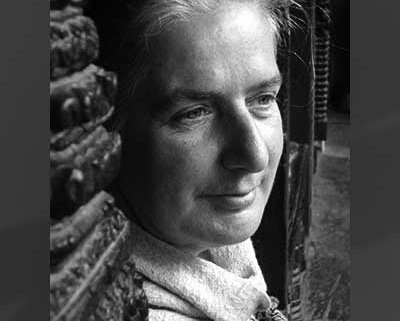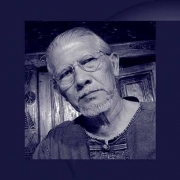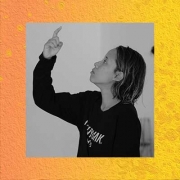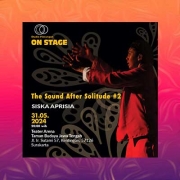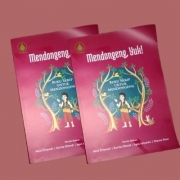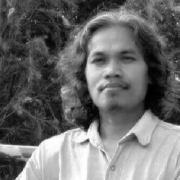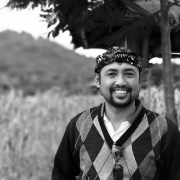Keys to a Contemplative Approach to Art-making and Art-living
by Diane Denis
A contemplative approach to the arts is not only a professional consideration, but an actual life-giving operation. It reminds us that the development of awareness (both physical and mental) involves a re-visiting of presumptions, of patterns and habits, hence the idea of Charnel Ground; it brings to light the ever-changing nature of living and dying. A contemplative approach also personally reminds me of Artaud’s theatre of cruelty. Yet, the promise of ‘radical honesty’ here is not only to cut through confusion but is most importantly life-affirming; filled with acknowledgement, kindness, and joy. Artaud’s understanding of the artist as an ‘emotional athlete’ here is redefined where the sport in which an artist trains is addressed specifically in terms of wisdom, hence the notion of the artist as sage.
The journey of a contemplative artist is necessarily rooted in an honest type of solitude and follows the curve of an inner quest; yet to its end, community and dialogue remain essential. Thanks! to Daniel Plá from the Universidade Federal de Santa Maria in Brazil and his team for organizing a recent conference on contemplative approaches to performing arts1. The conference was more than just a series of talks – it was experiential in its make-up and allowed us as a community of contemplative artists to address some of the most pressing and difficult questions of our time. In a series of talks by Drama School Mumbai curated by Amy Russell titled Unrehearsed Future,2 other dialogues of the kind have begun to ferment during the pandemic. There is an inter-play of influence, yet, it is after I watched Laurie Anderson’s 2021 Norton lectures and re-read Barbara Dilley’s book This Very Moment (2015)3 on Contemplative Dance Practice; that I felt the need to forage through my own journey for keys to a contemplative approach. I organized this foraging according to a genealogy (or one could say a skeleton) of inspirations, mixing first-, second-, and third-person accounts. These keys serve as the ground for my reoccurring Buddhist Art course offered at Rangjung Yeshe Institute (https://buddhistartexhibit.wordpress.com/).
And so, in this archeological dig, in this fine-tooth combing of past sensory data, I start here with my sister’s influence: I am 6, she is 13 years old – she is involved in theater at school in her blossoming of breath and qualities – I already sense in the artist’s journey a model of living and of being in the world. The artist as sage? A getting out of habitual ways of being? Is it freedom that I sense? I cannot quite put my finger on it. In the 1970s, Quebec’s francophone cultural environment is really rich and bubbling.
While exploring theater and music at age 16 with Jean-Michel Lamothe in Montreal, I visit some classics like Moilère and Schubert…an uplifting sense of aesthetic. Yet, in contrast and at the same time, an awareness of the notion of cruelty – reading Artaud’s term ‘cruel’ in the sense of sharp and genuine honesty with oneself, one’s nature, one’s human nature. The problem with my reading of Artaud’s work and of many other artists’ writing of the time is that it somehow leads me to depression, to a subtle form of aggression, to unconstructive anger toward injustices. I now attribute this to the development of sharpness of the intellect without accessing the tools to deepen the kindness of the heart. So, I mostly see the problems and faults with the world/with politics/with oppression/ with the culture of materialism/ with other people/with myself without deepening the ability to appreciate what is there. It all becomes an either/or situation. What about the awareness of the brilliance of life, and of nature? In the Buddhist tradition, one speaks of the aesthetic of basic goodness or Buddha nature – in Sanskrit, tathāgatagarbha; in Tibetan, de bzhin gshegs pa’i snying po.
I think there is a key here to an ‘artist as sage approach’, let’s call it, Key #1 – on such a journey, there is the necessity for deep appreciation as much as for sharp and genuine honesty or sharp thinking. In Buddhism, we could say ‘seeing things as they are’, and the ability to stop at bare perception. But can we do this? Can we really stop at bare perception?

As a young adult, I meet generosity and patience in Diane Campbell on Prince Edward Island who teaches me dance in the form of private lessons as I am too timid. Yet the flame for movement studies, she ignites in my bones right there and then. Back in Montreal, comes a training in theater directing using Beckett’s Waiting for Godot. I train with Eugene Lion4 – in what I would also call a contemplative approach – looking for the genuine heart. Three points to be made, points that will be strongly reinforced in my studying of Buddhist thought:
ï He says: “The masterpiece is yourself” – and here is my second key – there is the necessity for reflexiveness in the process of creation (self-reflexiveness in other words, a mirroring effect) to take into consideration (Key #2);
ï He says: “performing is like jumping off a second story building” – taking the risk to be exposed. I now associate this key with an elephant-like-confidence5. An effortless inner strength – where fearlessness is not the absence of fear (as the Prajñāpāramitā Sūtra literature indicates and as the scholar Christie Kilby6 reminds us), but a recognition of one’s inherent power just as it is; nothing more yet nothing less (Key #3); and
ï He says: “you need to focus”. To bring this to light Eugene holds two pencils – one in each of his hands, half a meter apart from each other – and then says: “focus!”. Obviously, I am only able to focus on one pencil at one time unless I use a panoramic view without fixation. There is the necessity to develop one pointed attention (Key #4) – in terms of pedagogy – I also learn here the importance of personal experience.
During that same period, I study with Jo Lechay7 – dance-movement with strong social and political content – addressing, for example, the freedom to create in Quebec while at that time, people were being killed in El Salvador. What do we do with unacceptable unbearable realities? Shutting them off is not an option. So here is my next key – the necessity to develop a genuine heart for others, other’s beauty, other’s strengths, other’s gifts, but also other’s plights (Key #5).
With this came the awareness of the ‘us’, not only Quebec’s national ‘us’ but the ‘us as sentient beings’ included in the quest for wisdom. How do ‘we’ become sages, or artists for that matter? I mean genuine artists. In other words, how do ‘we’ become sharp-appreciative, self-reflexive, with elephant-like-confidence and one-pointed-focused able citizens of the world? I explored Native American teachings – Mitakuye oyasin in Lakota language pronounced mi-TAHK-wee-a-say or Mee-tah-koo-yay Oy-yah-seen – a dedication meaning to ‘All my relations’ – we are, in fact, intimately and irremediably interconnected.
Then, comes Naropa University and a meeting with Trungpa Rinpoche, but only in mind as he passed into parinirvāṇa before I land in that maṇḍala. As I sit in the bus from Denver to Boulder, I keep hearing a timeless voice while looking at the reflection of my own face in the window mixing with the flat face of the mountains outside. The voice says: “watch carefully, listen attentively”, slowly, over and over again … “watch, watch carefully – listen; listen attentively”. With this injunction, an injunction that still echoes up to this day, comes the re-visiting of presumption: What is the self? Who sees? Talks? Acts? Who takes refuge? A contemplative approach to the arts is not only a professional consideration, but an actual life-giving operation. What is life-giving necessarily involves letting go, letting be. The development of awareness (both physical and mental) involves a re-visiting of presumptions hence the idea of Charnel Ground; it brings to light the ever-changing nature of living and of dying. A poignancy.
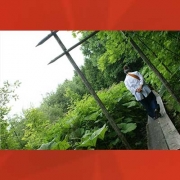
Diane Denis walking in a garden called “Jardins de vos rêves” in St-Ferdinand, Québec photo by Nicole Berbier
According to Trungpa, contemplative education is putting the student at the center of pedagogical concern. Here one does not think of a so called ‘generic student’ or a ‘generic artist’ but the specificity of each individual’s journey. To contemplate this idea further, one can use Trungpa’s insights found in his book Cutting through Spiritual Materialism (1973) and collection of Dharma Art essays True Perception (2008). One can use the work of Judith Simmer-Brown or of Barbara Dilley and so many others like the seemingly unrelated work on ‘critical constructive thinking’ or ‘skills-based approach to education’. There are many things to say about a contemplative approach here, too many – but for now I’ll just mention a few more key points.
As said above, a contemplative approach is necessarily oriented toward wisdom, specifically inspired by what I call, ‘operative Buddhist philosophy’, and by the notion of basic goodness or inherent fundamental intelligence present in all beings. It is joy-full and life-giving:
ï Establishing the groundless ground (Key #6) refers to the need to understand the way sensory and mental faculty function (Abhidharma). Exercises proposed for this: contemplative photography8 in three steps (flash/stabilizing/equivalence). Whatever form of art one is working with, developing the acuity of each door of perception is life-affirming, enriching; it deepens the connection to one’s own nature and to all that is around.
ï Accounting for emotions (Key #7) refers to the benefit of getting a clearer sense of what emotions are about – an extraordinary fuel – emotional hygiene is foremost. This is particularly important to prevent burn out and/or undue arrogance – emotions bring us back to mindfulness and one-pointed concentration, to full presence, to the poignancy of not knowing.
ï Placing intellectual inquiry in a proper framework (Key #8) refers to seeing the gift of critical thinking and its limits. We could speak, as Makransky does, of ‘critical-constructive’ thinking9; or as I often call it ‘operative critical thinking’ – which means understanding that every act of the mind has a consequence on experience; it also means that any conception of the world, of others and of oneself has a consequence on perception, on one’s experience of the world, on All one’s relations.
ï Taking the spiritual journey into account (Key #9), never letting go, which means always letting go.
In considering Barbara Dilley’s This Very Moment and her Contemplative Dance Practice (CDP), three keys can be added for contemplation, an exploration of ungraspable statements:
ï Key #10 – She says: “body and mind – not two not one”; where does that leave us…in the open space of awareness perhaps?
ï Key #11 – She speaks of ‘kinesthetic delight’ as the central piece of all activities, whether filling up income tax forms, standing in the studio, sitting on the cushion. Kinesthetic delight is a doorway to now-ness; to this very moment. Alongside CDP, exploring kinesthetic delight can be via brush stroke practice as in the artwork of François Cheng11 or of Robert Faure11 or via the Body-Mind Centering® work of Bonnie Bainbridge Cohen12.
ï Key #12 – She refers to Gertrude Stein’s phrase of ‘continuous present’. If kinesthetic delight brings one to now-ness, now-ness is as fluid as a river, ever flowing…
Yet, after all of that, it is with the influence of Khenpo Tsultrim Gyamtso Rinpoche (KTGR) that the idea of non-conceptual wisdom really takes me off my habitual patterns of living, creating, exploring, teaching and performing. He repeatedly speaks of ‘non-dual awareness’ and instructs me to study the fourth century Dharmadharmatāvibhāgakārikā (the Stanzas Distinguishing the Relative from the Genuine)<sup13 which, in turn, leads me to become a Buddhist Studies scholar. This text, attributed to Maitreya, involves a potent question: what do we, as sentient beings, rely on? The earth? The body? The community? Our own volition? What do we really rely on? With its analysis, an answer is pointed at: when one relies on duality (a separation between subject and object), confusion and suffering arise. Yet, when one relies on inherent wisdom, on suchness, on non-duality; then genuine-ness is palpable. This is further brought to the fore by the poet Milarepa and his timeless songs of realizations. Singing and dancing may in fact be the most important things to do at this time.
Aligning body, speech, mind in a non-dual, non-referential orientation (one could say dis-orientation and non-orientation) where mind and body, self and other, inner and outer appear without being reduced to this seeming dichotomy or to any concept whatsoever: the world of phenomena manifesting, and its empty luminous nature simply seen. Then and perhaps only then, there is a pure delight, like a coming home, a genuine artist dancing in the Charnel Ground.
In the Himalayan Buddhist traditions, there are ancient ritual movement practices that explore and invite this non-dual awareness – these are called vajranṛtya (vajra-dance) and caryānṛtya (practice-dance). One of my master’s degree students at Rangjung Yeshe Institute, Moondil Jahan14, regroups these practices under the term sādhana-nṛtya (ritual dance practices). I encourage keeping an eye out for her thesis, which should be available in 2022. These ritual dance practices can use strict forms such as wisdom ḍākinī as symbolic postures associated with the five Buddha families15.
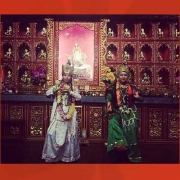
Vajra dance using the form of deities by Tek Chok Ling monastics, 1 March 2020, photo by Moondil Jahan
These awareness practices can also be ‘formless’ following the siddha tradition and have been promoted by Khenpo Tsultrim Gyamtso Rinpoche amongst nuns, monks and laypeople at monasteries in Nepal and Bhutan16 It resembles the contemporary improvisation movement practices in tune with nature like those of Diane Butler17 or Barbara Dilley.
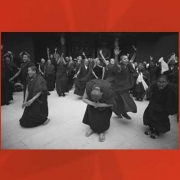
Formless Vajra Dance practice in the presence of Khenpo Tsultrim Gyamtso Rinpoche at Tek Chok Ling nunnery, Nepal, May 2010
All in all, as I close in on the genealogy of influence to date, the contemplative approach implies beginning again and again, a constant letting go, a constant returning, an ever moving wave of love without contention. That is the aesthetic of emptiness!
—-
Endnotes
12nd Seminar on Performing Arts and Contemplative Practices: contemplation, performing arts and coexistence: https://www.grupotradere.com/seminar
2See Drama School Mumbai Unrehearsed Futures: Theatre Pedagogy in Changing Times https://dramaschoolmumbai.in/unrehearsed-futures-drama-pedagogy-in-the-post-covid-world/#:~:text=Unrehearsed%20Futures%20is%20a%20series%20of%20public%20conversations,and%20address%20the%20new%20realities%20of%20teaching%20drama.
3Dilley, Barbara. 2015. This Very Moment. Digital Edition: 2020. Northampton, MA: Contact Editions. https://contactquarterly.com/contact-editions/title/this-very-moment
4On American theater director, writer Eugene Lion, see https://en.wikipedia.org/wiki/Eugene_Lion
5I recently taught a course on the Prajñāpāramitā Sūtra literature at Rangjung Yeshe Institute, Kathmandu University, in this wide and complex corpus of texts, bodhisattvas are sometimes likened to elephants – I take this to mean that bodhisattvas develop ‘elephant-like-confidence’.
6About Kilby’s work on the interface between Buddhism and International Humanitarian Law, see https://www.jmu.edu/philrel/people/kilby-christie.shtml. See also: https://soundcloud.com/rangjung-yeshe-institute/the-gift-of-fearlessness-buddhism-and-the-protection-of-vulnerable-populations-in-times-of-war
7On Canadian dancer, choreographer, painter Jo Lechay, see https://en.wikipedia.org/wiki/Jo_Lechay
8See The Practice of Contemplative Photography: Seeing the World with Fresh Eyes by Andy Karr with Michael Wood (2011), Shambhala Publications. See also Andy Karr interview at https://www.youtube.com/watch?v=jlV90muTzEc; also Julie DuBose interview on “Effortless Beauty” and Contemplative Photography (2013) at https://www.youtube.com/watch?v=BxWshdpJI1k and interview of Mitsue Nagase on Contemplative Photography Using the Art of Miksang (2020) at https://www.youtube.com/watch?v=L1GOAA643_A
9See johnmakransky.org, in particular www.johnmakransky.org/downloads/Makransky_Global_Buddhism_08.pdf
10On poet, calligrapher, scholar François Cheng, see https://en.wikipedia.org/wiki/Fran%C3%A7ois_Cheng
11On painter Robert Faure, see L’Esprit du geste, philosophie et pratique – De la peinture à l’encre de Chine.
12On Body-Mind Centering® founder Bonnie Bainbridge Cohen, see https://bonniebainbridgecohen.com/
13See my forthcoming article in the Journal of Buddhist Philosophy about the fourth century Dharmadharmatāvibhāgakārikā text. One can also consult the work of Karl Brunnhölzl, of Klaus Dieter Mathes, and of the translation of the Dharmacakra Committee.
14On MA Candidate, CORE Fellow, and Aseemkala Initiative board member Moondil Jahan, see https://aseemkala.org/moondil-jahan/
15Photo of vajra nṛtya using deity postures (vajra dance) at Tek Chok Ling, https://studentblog.ryi.org/category/rinpoches-birthday/
16Photo of formless practice vajra dance with KTGR at https://khenpo-rinpoche.blogspot.com/, see also Khenpo Tsültrim Gyamtso Rinpoche | Teachings and Activities http://www.ktgrinpoche.org/
17See Diane Butler’s https://awakeningartworkshops.wordpress.com/; see also Prebish and Baumann (2002), Westward Dharma: Buddhism Beyond Asia, Berkeley, CA: University of California Press, p. 318.
—–
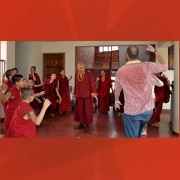
Dr Diane Denis
Dr. Diane Denis graduated with an MFA from Naropa University in Boulder, Colorado, a leading center for contemplative approaches to the arts and to education. During that period, she also pursued a traditional curriculum at Marpa Institute for Translators, and at Rigpe Dorje Institute – grounding her work in operative philosophical understanding. She completed her PhD at Laval University in Quebec, Canada, in 2013. She founded the Wandering Yogic Wisdom Art Festival (WYWAF), thus creating a place to explore Buddhist inspired living wisdom through creative and artistic expression. Dr. Denis now pursues her research by examining contemplative approaches to many areas of studies. She is also the founder of the Sahle Ö Project (named in honour of one of the four women disciples of Milarepa) a charitable organization supporting women’s higher education (monastic and lay) in Tibet, Nepal, Bhutan as well as supporting the study and practice of Buddhism in the West (https://projetsahleo.wordpress.com/). She has taught at Naropa University, at Acadia University, at Laval University and now at Kathmandu University, Rangjung Yeshe Institute (Rangjung Yeshe Institute | (ryi.org)) She is also active in several Buddhist Centers in Nepal, Europe and North America.


